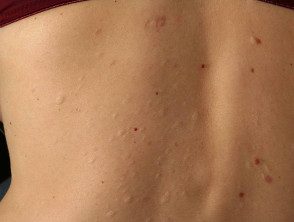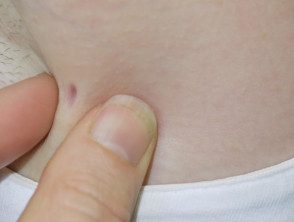What is anetoderma?
Anetoderma is a rare condition in which the elastic tissue in the dermis is lost, resulting in a depression in the skin. Also known as macular atrophy.
Who gets anetoderma and why?
Anetoderma affects women more commonly than men, and the usual age range is 15 to 25 years. Maybe there is an increase incidence in premature babies, especially those with very low birth weight, and lesions can develop where adhesives such as for monitoring leads have been attached.
Anetoderma seems to be the most commonly reported in Central Europe.
There have been rare cases of anetoderma affecting family members, including monozygotic (identical) twins.
There are two forms of anetoderma: primary and secondary. The cause of the primary form is unknown.
Secondary anetoderma occurs at the site of other unrelated skin conditions including:
- Infections: chickenpox, syphilis
- Tumors: pilomatrixoma, plasmacytoma, schwannoma, cutaneous Cell B lymphoma, youth xanthogranuloma
- Childish hemangioma
- Inflammatory skin conditions: acne, granuloma annulare, deep lupus
Both forms of anetoderma can be associated with systemic diseases including:
- Infections: Lyme disease (Borrelia), leprosy, HIV infection
- Inflammatory/autoimmune conditions: systemic lupus erythematosus (SLE), Graves disease, Addison's disease, Sjögren syndrome,
- Medications - penicillamine
There appears to be a particular association with the presence of antiphospholipids antibodies, often without the other features necessary to diagnose antiphospholipid syndrome.
The old classification of the Schweninger-Buzzi and Jadassohn-Pellizari types, non-inflammatory versus inflammatory, is no longer considered useful as both types of injury can be seen in a patient and many clinically non-inflammatory lesions show inflammation in histology. This classification does not predict forecast and therefore it is no longer used.
Many theories have been proposed to describe the mechanism of development of anetoderma, but at this time this remains unknown.
Clinical characteristics of anetoderma.
The typical clinical presentation of anetoderma is multi-turn. well defined 1–2 cm lesions with wrinkled skin covering a palpable depression, the so-called buttonhole sign.
Lesions may be flat, raised, or depressed, skin-colored, or bluish-white.
Anetoderma lesions are most commonly found on the chest, back, neck, and arms, but anywhere can be affected. They are not related to hair follicles.
Anetoderma




Chicken pox scars

Deep lupus
How is anetoderma diagnosed?
Anetoderma should be considered clinically for pathologist knows how to make special spots on the skin biopsy These specimens are needed to demonstrate the loss of elastic fibers in the upper to middle dermis. In routine spots, the skin looks relatively normal, perhaps with some signs of inflammation.
Some authors suggest doing blood tests for Borrelia serology where appropriate, and for autoimmune conditions, including antiphospholipid antibodies (lupus anticoagulant and anticardiolipin).
What is the treatment for anetoderma?
There is no successful treatment to reverse the already formed anetoderma lesions. Individual lesions can be excised. When an underlying condition has been diagnosed, successful treatment can prevent further lesions from forming.
